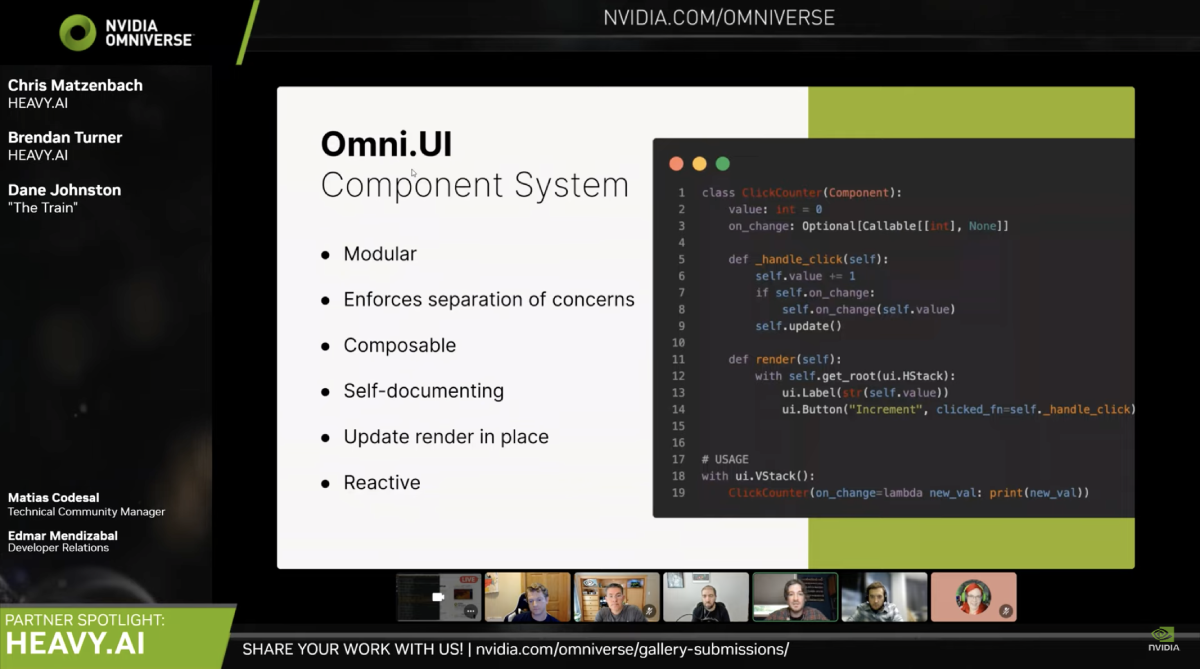This component system was first presented during a NVIDIA Partner Spotlight with HEAVY.AI and can be found here on YouTube
- Provide a means to encapsulate functions and
omni.uiwidgets to modularize UI code by its purpose to enforce boundaries using separation of concerns - Standardize the creation and implementation of UI components in a manner that enforces self-documentation and a homogenous UI codebase
- Provide the utility of updating and re-rendering specific components without re-rendering components that have not changed
from heavyai.ui.component import Component
class SimpleLabel(Component):
def render(self):
ui.Label("Hello World")
# USAGE
SimpleLabel()
class CustomLabel(Component):
value: str = "Hello World"
def render(self):
ui.Label(self.value)
# USAGE
CustomLabel(value="Hello There")from heavyai.ui.component import Component
class ButtonCounter(Component):
value: int = 0
on_change: Optional[Callable[[int], None]]
def _handle_click(self):
self.value += 1
if self.on_change:
self.on_change(self.value)
self.update()
def render(self):
with self.get_root(ui.HStack):
ui.Label(str(self.value))
ui.Button("Increment", clicked_fn=self._handle_click()
# USAGE
ButtonCounter(on_change=lambda val: print(val))from heavyai.ui.component import Component
class UsdSubscribingComponent(Component):
prim: pxr.Usd.Prim
def __init__(self, **kwargs):
super().__init__(**kwargs)
self.subscription: carb.Subscription = (
usd.get_watcher().subscribe_to_change_info_path(
path=self.prim.GetPath(), on_change=self._handle_prim_change
)
)
def _handle_prim_change(self, prim_attr_path):
self.update()
def render(self):
with self.get_root(ui.VStack):
pass
def destroy(self):
self.subscription.unsubscribe()
class AbstractModelSubscribingComponent(Component):
model: sc.AbstractManipulatorModel
def __init__(self, **kwargs):
super().__init__(**kwargs)
self.subscription: carb.Subscription = (
self.model.subscribe_item_changed_fn(
self._handle_model_item_changed
)
)
def _handle_model_item_changed(self, model, item):
self.update()
def render(self):
with self.get_root(ui.VStack):
pass
def destroy(self):
self.subscription.unsubscribe()Similar to the ability to update the style property of any ui.Widget element or the text property of ui.Label and ui.Button elements, Components can also be updated after they are created. Components can update themselves in response to subscribed events or user interactions, or components can be updated elsewhere via reference. This drastically increases the composability of UI elements.
class CustomLabel(Component):
value: str = "Hello World"
def set_value(self, value: str):
self.value = value
self.update()
def render(self):
ui.Label(self.value)
hello_world_label = CustomLabel()
hello_world_label.set_value(
"Goodbye, and see you later"
)hello_world_label = CustomLabel()
hello_world_label.value = "Goodbye, and see you later"
hello_world_label.update()Components are not automatically deleted when cleared from a container (or should otherwise be destroyed), so if a destroy() method is provided, a reference to that component must be stored and destroyed by the component’s “parent” when appropriate, resulting in a chain of saved references and destroy calls. This is often the case when a component sets up a subscription; the subscription must be unsubscribed when the component is removed. See 'Subscribing Components' above for examples of components that require a destroy method.
class ParentComponent(Component):
def render(self):
prim = # get prim reference
with self.get_root(ui.VStack):
self.child = UsdSubscribingComponent(prim=prim)
def destroy(self):
self.child.destroy()